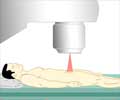A new web tool, PREDICT Prostate, can accurately predict the prognosis and need for treatment in patients with early-stage prostate cancer by stratifying patients based on survival.
- PREDICT Prostate, a new web tool, can better inform the need for treatment and prognosis for patients with early-stage prostate cancer
- It stratifies patients on the basis of survival, which is taken to be the ultimate end-point of therapy
- The tool prevents misdiagnosis of prostate cancer, thereby saving patients from unnecessary treatments with severe side-effects
The web tool has been developed in collaboration with the Winton Center for Risk and Evidence Communication, located within the Department of Pure Mathematics and Mathematical Statistics at the University of Cambridge, UK.
The study, published in PLOS Medicine, was led by Dr. Vincent Gnanapragasam, MBBS, BMedSci, MA, PhD, FRCS, FRSCEd (Urol), who is a University Lecturer in Uro-oncology and an Honorary Consultant Urologist at the University of Cambridge, UK.
The lead author of the study was Dr. David Thurtle, BMedSci (Hons), BMBS (Hons), MRCS, who is an Academic Clinical Fellow in Urology at the CRUK Cambridge Center, University of Cambridge, UK.
The study was conducted in collaboration with Dr. Paul Pharoah, who is a Professor of Cancer Epidemiology at the Center for Cancer Genetic Epidemiology, Department of Public Health and Primary Care, University of Cambridge, UK.
Read More..
Prostate Cancer & its Classification
Prostate cancer affects the prostate gland in men, which is a small walnut-shaped gland, located below the urinary bladder and surrounding the urethra. It produces seminal fluid, which is an important component of semen.Cancer Research UK statistics reveal that 47,151 new cases of prostate cancer were reported in 2015 from the UK. Prostate cancer usually occurs in old age; disease progression is slow and is not always life-threatening. However, in a significant number of men, cancer can metastasize and spread to other parts of the body, which can be fatal.
Currently, prostate cancer is classified as low, intermediate or high risk. Depending on the severity, the doctor recommends either patient monitoring or treatment. The latter involves radiotherapy or surgery, which are associated with significant side-effects such as urinary incontinence and erectile dysfunction.
However, the current classification system, which is based on the National Institute for Health and Care Excellence (NICE) Guidelines, is only 60-70 percent accurate. This means that patients, who are advised treatment, may not actually need it. This has been substantiated by a recent UK study, which found that for patients with early prostate cancer (low and intermediate risk); the 10-year survival for those who received treatment was the same as those who didn’t receive any treatment.
Salient Features of the Study
- Data were obtained from the UK National Cancer Registration and Analysis Service (NCRAS)
- The study was carried out between 2000 to 2010
- Study population included 10,089 men diagnosed with non-metastatic prostate cancer from Eastern England
- External validation cohort included 2,546 men diagnosed with non-metastatic prostate cancer from Singapore
- Median follow-up was 9.8 years with 3,829 deaths, of which 1,202 were due to prostate cancer
- The various treatment modalities and their frequency are presented below:
- Radiotherapy: 34.6 percent
- Androgen deprivation monotherapy: 31.5 percent
- Conservative management: 19.8 percent
- Prostatectomy: 14.1 percent
- PREDICT Prostate predicts the personalized 10-15 year survival rate based on the following parameters:
- Age at diagnosis
- Prostate-specific antigen (PSA)
- Clinical stage
- Hospital admissions (past 2 years)
- BRCA status
- Histological grade
- Gleason score
- Biopsy data
Advantages of PREDICT Prostate
- Stratifies non-metastatic prostate cancer patients on the basis of survival rather than treatment outcomes, which is the current norm
- Not only predicts the 10-15 year survival rate, but also the impact of opting for monitoring vs treatment on survival
- Can predict the likelihood of success of treatment intervention, as well as the possible risk of side-effects
- Has improved the accuracy of classification to more than 80 percent as opposed to 60-70 percent, based on the NICE Guidelines
- Could potentially reduce costs incurred by the National Health Service (NHS), arising from unnecessary treatment due to the poor predictive power of clinical evaluation alone. This could mean savings of over £7,000 per patient who undergo radical treatments such as surgery or radiotherapy. The current rate of these procedures, based on data from the National Prostate Cancer Audit, UK is 2-25 percent. Besides the cost factor, these procedures also have significant side-effects
Validation of PREDICT Prostate
The accuracy of the predictive power of PREDICT Prostate has been validated in a randomized study consisting of almost 200 prostate cancer specialists. Half of them had access to the web tool as well as patient vignettes, while the other half had access to only the vignettes. Clinicians without access to PREDICT Prostate were more prone to overestimate the risk of death, thereby recommending treatment. On the other hand, those clinicians who had access to PREDICT Prostate were less likely to recommend treatment, based on the more accurate prognostic estimate provided by the web tool.Strengths of the Study
Since the study was based on highly accurate, detailed and comprehensive data, provided by the UK’s National Cancer Registration and Analysis Service (NCRAS), the predictive power of PREDICT Prostate was increased manifold.Limitations of the Study
The major limitations of the study include the following:- Relatively small size of the external validation cohort from Singapore
- Inability to anticipate the delayed changes to treatment beyond one year
- Absence of tumor-stage subclassifications
- PREDICT Prostate can only be used in consultation with a doctor
- The web tool is unsuitable for patients with very aggressive cancer
- The web tool cannot be used if metastasis has already occurred at the time of diagnosis
Concluding Remarks
PREDICT Prostate is a personalized prostate cancer prognostic tool built from baseline diagnostic data. Despite inputs from routine pathological information, its prognostic power is considerable and is capable of predicting potential treatment benefits on overall survival. In this regard, Thurtle says: “As far as we are aware, this is the first personalized tool to give an overall survival estimate for men following a prostate cancer diagnosis.”Thurtle concludes: “PREDICT Prostate is designed for men who are considering whether to choose to monitor or to opt for treatment. This is the choice that faces nearly half of all men who are diagnosed with prostate cancer. We hope it will provide a more accurate and objective estimate to help men reach an informed decision in discussion with their consultant.”
Funding Source
The study was funded by The Evelyn Trust, Cambridge and The Urology Foundation, London, UK.Reference:
- Individual Prognosis at Diagnosis in Nonmetastatic Prostate Cancer: Development and External Validation of the PREDICT Prostate Multivariable Model - (https://journals.plos.org/plosmedicine/article?id=10.1371/journal.pmed.1002758)
Source-Medindia








![Prostate Specific Antigen [PSA] Prostate Specific Antigen [PSA]](https://www.medindia.net/images/common/patientinfo/120_100/prostate-specific-antigen.jpg)







